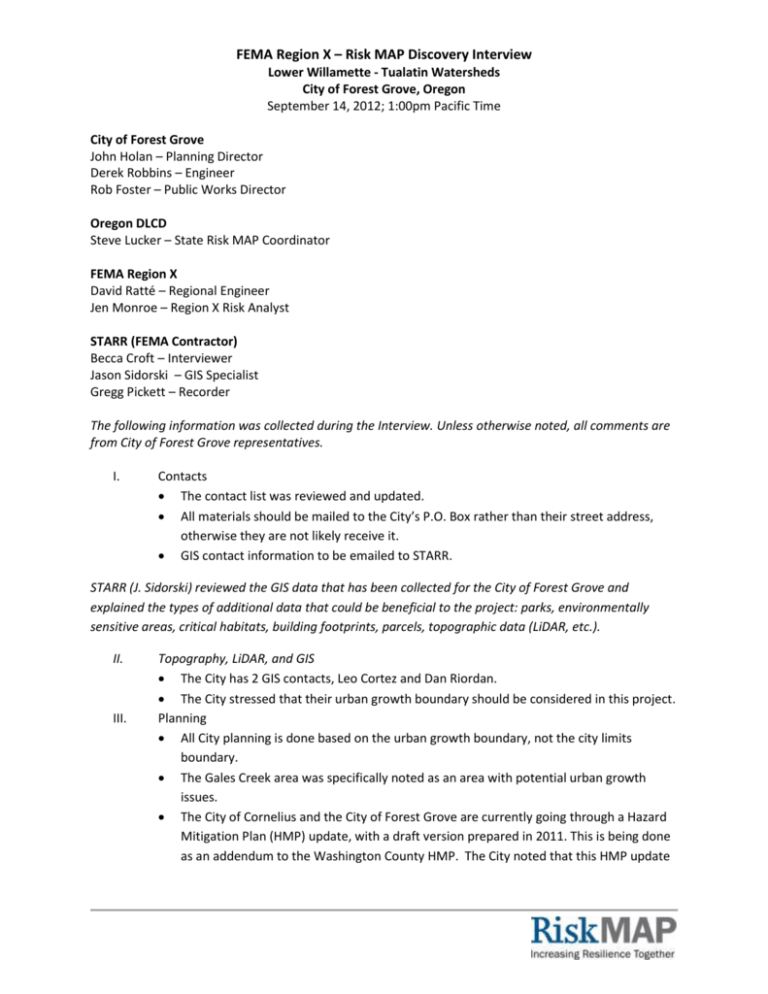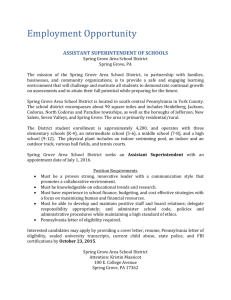FOR FEMA AND STATE REVIEW-Meeting Minutes Forest
advertisement

FEMA Region X – Risk MAP Discovery Interview Lower Willamette - Tualatin Watersheds City of Forest Grove, Oregon September 14, 2012; 1:00pm Pacific Time City of Forest Grove John Holan – Planning Director Derek Robbins – Engineer Rob Foster – Public Works Director Oregon DLCD Steve Lucker – State Risk MAP Coordinator FEMA Region X David Ratté – Regional Engineer Jen Monroe – Region X Risk Analyst STARR (FEMA Contractor) Becca Croft – Interviewer Jason Sidorski – GIS Specialist Gregg Pickett – Recorder The following information was collected during the Interview. Unless otherwise noted, all comments are from City of Forest Grove representatives. I. Contacts The contact list was reviewed and updated. All materials should be mailed to the City’s P.O. Box rather than their street address, otherwise they are not likely receive it. GIS contact information to be emailed to STARR. STARR (J. Sidorski) reviewed the GIS data that has been collected for the City of Forest Grove and explained the types of additional data that could be beneficial to the project: parks, environmentally sensitive areas, critical habitats, building footprints, parcels, topographic data (LiDAR, etc.). II. III. Topography, LiDAR, and GIS The City has 2 GIS contacts, Leo Cortez and Dan Riordan. The City stressed that their urban growth boundary should be considered in this project. Planning All City planning is done based on the urban growth boundary, not the city limits boundary. The Gales Creek area was specifically noted as an area with potential urban growth issues. The City of Cornelius and the City of Forest Grove are currently going through a Hazard Mitigation Plan (HMP) update, with a draft version prepared in 2011. This is being done as an addendum to the Washington County HMP. The City noted that this HMP update Risk MAP Discovery Interview – Lower Willamette - Tualatin Watersheds City of Forest Grove – September 14, 2012 IV. V. VI. VII. Page 2 of 4 may not take the City’s Comprehensive Plan into consideration. Assistance from Region X to complete this work was requested by the City. Critical City structures in the event of an emergency include the local hospital, schools, the fire station/emergency control center, and the water plant. The water storage facilities that are located on David Hill are extremely critical to the City. Earthquakes Earthquakes reaching 9.2 on the Richter scale are possible in the city of Forest Grove. There are two known faults in close proximity to Forest Grove; one near Hagg Lake and the other along Gales Creek. There are a number of unreinforced masonry structures in the downtown area. There are currently no plans in place to reinforce these structures. Wildfires No regulations have been adopted, but the local fire department is a good source of information for residents regarding wildfire hazards, proper buffers, etc… David Hill will continue to grow as a wildfire concern as development continues up the hill. North Gales Creek Road, in the NW portion of the city, is currently the biggest concern. Forest Grove owns a 5,000 acre forested watershed northwest of the city in the Upper Gales Creek area. This area is closed to the public. There are significant timber assets there, with the potential for wildfire. Landslides David Hill has 15 to 20 residential units had to have special construction of their foundations due to the slope of the topography and the soil. This area has shallow groundwater and has slick soils, making it very susceptible to landslides. Soils on David Hill are so slick that when initial construction was underway for a reservoir, portions of the project slid down the hill somewhat. 150 residential units were placed in one area on/near David Hill, and the planning process failed to take the special conditions into consideration during the preliminary review process. Newer building regulations for the area are now much more strict. There is the potential of a landslide into nearby Hagg Lake, which could possibly put the structural integrity of the dam at risk. The northwest portion of the city has the highest potential for growth, but also the highest potential for landslides. Additional growth of 1400 to 1500 residences is possible. Severe Storms The local fire department study would be the best place to get data and policies regarding severe storms. The city experiences occasional power outages and fallen trees, especially from windstorms, but no long term problems typically occur. Forest Grove has its own light and power company, so outages are typically short. Risk MAP Discovery Interview – Lower Willamette - Tualatin Watersheds City of Forest Grove – September 14, 2012 VIII. Page 3 of 4 Forest Grove has not had the need to shelter people in the past. The fire department’s management plan should be referred to for information regarding outreach. Flooding The Homestead (a senior community) was sandbagged in 1996 to keep the rising water of the Tualatin River out. The whole area near the Homestead has relatively poor stormwater drainage. Forest Grove’s largest private employer is located in the poor drainage area in the eastcentral portion of the city. The Dairy Creek Bridge, just west of Hillsboro on the Tualatin Valley Highway, flooded in 1996, and caused significant access problems for residents of the community, although this bridge in not located within the city of Forest Grove. The approaches to the bridge were overtopped by the flooded creek, causing the bridge to be temporarily closed. This bridge, maintained by the Oregon Department of Transportation, has been slated for a seismic retrofit, but no known changes to the bridge are known to alleviate problems associated with flooding. Scoggins Dam which impounds Hagg Lake, was built in the mid-70’s to withstand a 7.5 earthquake. Some of the city’s water supply, as well as the water supply to some other area communities, comes from this lake. Since recent studies have suggested that a 9.2 earthquake (Richter scale) is possible in the area, the dam is currently being studied for the potential of a seismic retrofitting. Water from Hagg Lake is released from Scoggins Dam and eventually makes its way down Scoggins Creek and eventually into the Tualatin River, where water intakes for a 75-million-gallon-a-day water treatment plant is located. This plant provides drinking water for a number of cities in the area. Inundation maps have been developed by the Army Corps of Engineers to show what would happen if Scoggins Dam were ever to fail. According to this study, a school and The Homestead senior community would be inundated in the event of a dam failure. According to the City, the effective 1982 Flood Insurance Rate Maps (FIRMs) were based on a faulty set of assumptions, and did not consider either a government levee or a a private levee located in the city. The preliminary Washington County FIRMs still do not address this issue, and according to the City are still wrong. The City was told by the Corps of Engineers that Gales Creek was not updated in the current restudy because it was too complex. Gales Creek area would be a prime area for any future detailed study, as would Carpenter Creek. Recent floods have been at least 8 feet above the elevations shown on the effective and new preliminary FIRMs. No specific past mitigation projects with grant funding were known. The City does not allow development in the 1-percent-annual-chance floodplain. Risk MAP Discovery Interview – Lower Willamette - Tualatin Watersheds City of Forest Grove – September 14, 2012 IX. X. XI. XII. Page 4 of 4 While no new structures have been built in the floodplain in recent years, a few older structures are located within the 1-percent and 0.2-percent-annual chance floodplains. Levees There is a government-maintained levee and a private levee located within the city of Forest Grove. Since the private levee was not built to current guidelines and specifications, it is not recognized as showing any flood protection on the effective FIRMs. Environmentally Sensitive Areas A wetlands inventory was completed in 1995 and was list was recently updated, and should be available from the Metro Regional Land Information System (Metro). Metro also has natural resource area data/maps. Washington County has vegetated corridor requirements that the City abides by, including stream buffers of 25 to 50 feet. Communications and Outreach Fire Department has likely done outreach, but specifics were not known at the time of the interview. Special outreach projects might be necessary if flood mapping projects were to proceed. The Community Development Department would be the best place for residents to go to obtain hazard information. STARR will give outreach materials to the City at the Discovery Meetings. Landslides on David Hill are the biggest risk, and City wants information about land use regulations and the best ways to implement them. The City would like information regarding upcoming training opportunities. Other City expects to attend the meeting in Beaverton at the Beaverton Library on September 24th.







